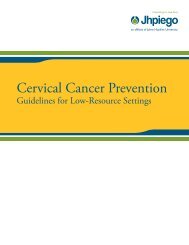Manual for Male Circumcision under Local Anaesthesia
Manual for Male Circumcision under Local Anaesthesia
Manual for Male Circumcision under Local Anaesthesia
You also want an ePaper? Increase the reach of your titles
YUMPU automatically turns print PDFs into web optimized ePapers that Google loves.
<strong>Male</strong> circumcision <strong>under</strong> local anaesthesia<br />
Version 3.1 (Dec09)<br />
or thermostat controls, where people might accidentally put their<br />
hand into them.<br />
• Attach containers to walls or other surfaces, if possible, at a<br />
convenient height, so that staff can use and replace them easily.<br />
• Mark the container clearly, so that people will not mistakenly use it<br />
as a rubbish bin.<br />
• Mark the fill line (at the three-quarters full level). Do not shake the<br />
container to settle its contents, to make room <strong>for</strong> more sharps.<br />
• Never attempt to empty the sharps container.<br />
Fig. 8.4 Puncture-proof containers <strong>for</strong> disposal of sharps<br />
PROCESSING OF INSTRUMENTS, ENVIRONMENTAL CLEANING AND<br />
MANAGEMENT OF SPILLS<br />
Soiled instruments and other reusable items can transmit infection if<br />
they are not properly reprocessed. Effective and safe reprocessing<br />
includes disinfecting instruments and equipment immediately after<br />
use, cleaning to remove all organic matter and chemicals, and highlevel<br />
disinfection or sterilization <strong>for</strong> instruments that will be used in<br />
normally sterile critical sites, i.e. within the body, in sterile tissue,<br />
cavities or the bloodstream. Be<strong>for</strong>e sterilization, all equipment must be<br />
disinfected and then cleaned to remove debris. Sterilization is<br />
intended to kill living organisms, but is not a method of cleaning.<br />
Disinfection<br />
Disinfectant solutions are used to inactivate any infectious agents that<br />
may be present in blood or other body fluids. They must always be<br />
available <strong>for</strong> cleaning working surfaces, equipment that cannot be<br />
autoclaved and non-disposable items, and <strong>for</strong> dealing with any<br />
spillages involving pathological specimens or other known or<br />
potentially infectious material.<br />
Used instruments should routinely be soaked in a chemical<br />
disinfectant <strong>for</strong> 30 minutes be<strong>for</strong>e cleaning. Disinfection decreases the<br />
viral and bacterial burden of an instrument, but does not clean debris<br />
from the instrument or sterilize it. The purpose of disinfection is to<br />
reduce the risk to those who have to handle the instruments during<br />
further cleaning. Disinfection is not a sterilizing process and must not<br />
be used as a substitute <strong>for</strong> sterilization.<br />
Prevention of Infection Chapter 8-11
















